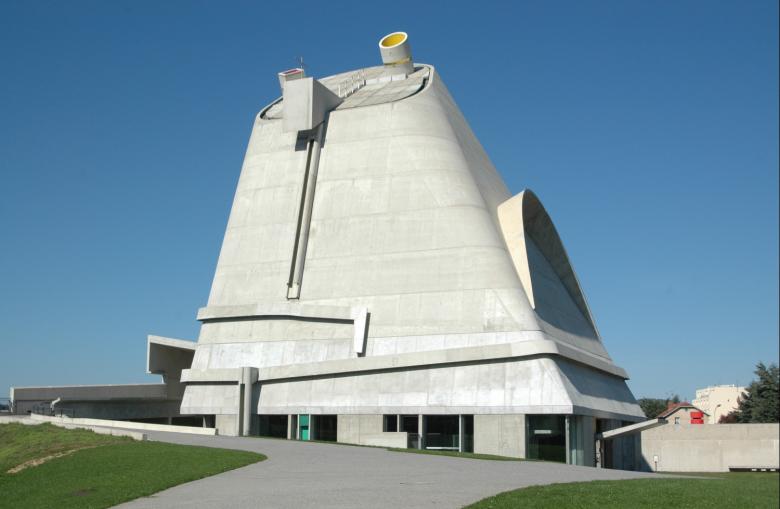13. March 2024
Saint-Pierre Church, Firminy, 1961–2006 (Photo: John Hill/World-Architects)
José Oubrerie, the French architect who worked in the studio of Le Corbusier and completed the Saint-Pierre Church in Firminy four decades after the death of Le Corbusier, died on March 10 at the age of 91. Oubrerie was the last living apprentice of Le Corbusier.
The number of buildings carried out by José Oubrerie could probably be counted on one hand, and most of those buildings originated with Le Corbusier, whom Oubrerie apprenticed for from 1963, following his Beaux-Arts education in France, until Le Corbusier's death in 1965. Most famous is the Saint-Pierre Church in Firminy, the French town that is home to Firminy-Vert, a grouping of Le Corbusier buildings that also includes a Unité d'Habitation, the Maison de la Culture, and a stadium. The church started construction in 1973 but stopped five years later, only to resume in 2004 and be completed in 2006 under Oubrerie. Although built close to its original design, the pyramidal building in concrete was voted by a panel of architects in 2010 as the second most significant building erected up to that point in the 21st century.
Other projects that Oubrerie worked on in the Paris studio of Le Corbusier were the Heidi Weber Pavilion, completed in Zurich in 1967, and the new Venice Hospital, which was canceled in the early 1970s. The former, now named Pavillon Le Corbusier, reopened in 2019 after extensive renovations, while the latter project has taken on near-mythic status in the decades since it was abandoned.
Pavillon Le Corbusier, Zurich, 1960–1967 (Photo: John Hill/World-Architects)
Oubrerie's own buildings are really just two: the French Cultural Center in Damascus, done with Kirkor Kalaycayian and engineer Jean Jacqutes Couvert between 1981 and 1986; and the Miller House built in Lexington, Kentucky, in 1992 with Cecily Wylde. Both are Corbusian in form and materials. In regards to the seven-story building in Syria, Kenneth Frampton wrote in the Italian journal Parametro in 1987 that “Oubrerie is able to apply and extend the fundamental lucidity of the Corbusian method,” including “the application of proportional control (Le Modulor) and […] an acute feeling for typological and cultural propriety.” Oubrerie himself said in a 2014 interview at Archinect that the cultural center was “a very close interrogation of [Corbu's] Villa la Roche.”
Of Oubrerie's few buildings, the Miller House is his masterpiece, a grand 5,000-square-foot composition in concrete, steel, and wood, known for its complex interior spaces that comprise three small “houses” suspended within a larger frame and sharing a common atrium space. To quote Frampton again, in his book American Masterworks, “it is essentially a pinwheeling, fugal composition in space that also happens to be a luxurious house designed to accommodate a family: a lawyer, his wife, and their two children. All four at various times live and work in different parts of the country so this house is intended as their home base.”
While the house recalls numerous Corbu projects, especially ones he built in Ahmedabad, India (Mill Owners Association Building, Villa Shodhan), the design is one of a kind, wholly unique to its programmatic circumstances and context. The house's distinctive forms and spaces made it a victim of vandalism this century, although it was carefully restored in 2017. McMansions encroached on the once-remote property, but thankfully fears of it being torn down for the construction of even more typical suburban houses were tempered in 2021, when the house was bought in an auction by hedge fund executive Stephen Taylor, “a fan of the architecture” who admitted, “the inside was just stunning — I love all the nooks and crannies.”
Born on November 9, 1932, Oubrerie studied painting at the École des Beaux-Arts in Nantes and architecture at École Nationale Supérieure des Beaux-Arts in Paris, before working for Le Corbusier in Paris. Following Corbu's death in 1965, Oubrerie started his own office in Paris but then relocated to the United States in the early 1980s, forming Atelier Wylde-Oubrerie in 1989.
Oubrerie was also an educator, having taught at numerous schools in the United States, most notably the University of Kentucky College of Design, where he was also dean, and at the Knowlton School of Architecture at Ohio State University from 1991 until his retirement in 2013. OSU professor Todd Gannon, who edited the 2014 book Et in Suburbia Ego: José Oubrerie’s Miller House, told The Architect's Newspaper this week that Oubrerie was “towering figure in our field, whose catalog of built work, though not extensive, is comprised almost exclusively of masterpieces.”
His few buildings may have been joined by another masterpiece, one that would have synthesized the buildings in Damascus and Lexington, but the Chapel of the Mosquitoes, commissioned in 2015 by Steven Holl's ‘T’ Space for a site in Rhinebeck, New York, remains unbuilt. Perhaps, like the Saint-Pierre Church in Firminy, the chapel will find realization after Oubrerie's passing.

